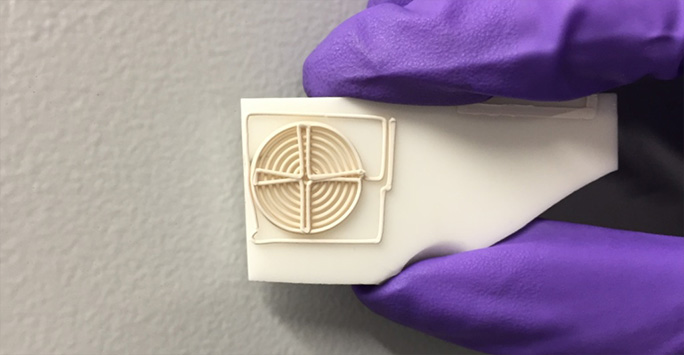Material formulation for the future of 3D printing
Few would doubt the ‘wow! factor’ and dizzying array of applications of 3D printing, from humble beginnings with car parts to today’s medical devices and battery parts.
When using ‘robocasting’ industrial 3D printers, which have a robotic arm in charge of the applicator, it is important to ensure that the printing material being used has been accurately formulated. If it doesn’t flow from the nozzle accurately and consistently it has little industrial or commercial future.
Next-generation wonder materials
Scientists at the University of Liverpool are now researching next-generation wonder materials like graphene, modifying them so they, too, can be used in programmable ‘robocasting’ 3D printers. “I work on formulations to bring lab-scale manufacturing to advanced new materials,” says Dr Esther García-Tuñón from the University of Liverpool’s School of Engineering and Materials Innovation Factory (MIF). “We want to bring new materials to 3D printing so we can make more complex devices like batteries for green energy production and parts for healthcare applications.”
García-Tuñón achieved significant recognition when her group (when she was a research associate in the CASC at Imperial College London) demonstrated for the first time how graphene oxide (GO) can be used to formulate water-based pastes to print a wide variety of materials such as polymers, ceramics and steel. She found that combining GO with other compounds alters materials’ viscoelastic response; enabling pastes with excellent printing characteristics like shear thinning flow (to get through the nozzle) with fast recovery of elastic properties (so it doesn’t form a puddle).
GO is now considered an all-in-one dispersant and viscosifier (thickener) that allows all sorts of new materials to be 3D-printed at certain particle shapes and sizes.

Investigating new formulations
A further advantage is that these new formulations are water-based, and avoid the use of organic solvents. “We want to design formulations people can use with ease, and if it’s water based its more safe, cleaner and often cheaper too,” says García-Tuñón. Now her team is working with collaborators, especially colleagues at the Materials Innovation Factory (MIF) at the University of Liverpool, to investigate even newer materials and formulations.
The MIF houses some of the newest and most advanced materials and formulation equipment in the world, and acts as a research conduit from academic theory to industrial and commercial application. The MIF brings industry and academia together under the same roof in the open access area. García-Tuñón is collaborating with pharmaceutical giant Unilever, also based in the MIF, to better understand the performance of personal care products by studying the connection between the bulk rheology (matter flow properties) and the microstructure of responsive formulations.
“In the MIF I have access to the best equipment, automated formulation platforms and robots working all day that have never been used before to study and develop formulations for 3D printing” she says. “You can create bespoke workflows with formulation and measurement processes to test quality and performance for potential large-scale manufacture.”
Elsewhere across campus she is working with University spin-out company Fusion Implants on bio-reabsorbable 3D-printed bone support structures containing calcium phosphates for veterinary applications.
World-leading hub of applied materials research
Her successful work and profile as an early-career academic has led García-Tuñón to successfully apply for Liverpool to host the Recent Appointees in Material Science (RAMS) meeting which will consolidate Liverpool’s place as a world-leading hub of applied materials research, especially beneficial for early career researchers.
She has also brought University schools together by creating a new module for undergraduates in chemistry and engineering to understand the fundamental science of formulations and how to measure their performance.